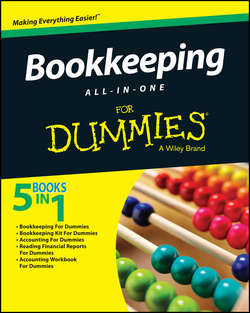Читать книгу Bookkeeping All-In-One For Dummies - Dummies Consumer - Страница 10
На сайте Литреса книга снята с продажи.
Book I
Keeping the Books
Chapter 1
Basic Bookkeeping
Finally Showing Off Your Financial Success
ОглавлениеProving out your books and ensuring they’re balanced means you finally get to show what your company has accomplished financially by developing reports to present to others. It’s almost like putting your business on a stage and taking a bow – well … at least you hope you’ve done well enough to take a bow.
If you’ve taken advantage of your bookkeeping information and reviewed and consulted it throughout the year, you should have a good idea of how well your business is doing. You also should have taken any course corrections to ensure that your end-of-the-year reports look great.
Preparing financial reports
Most businesses prepare at least two key financial reports, the balance sheet and the income statement, which it can show to company outsiders, including the financial institutions from which the company borrows money and the company’s investors.
The balance sheet is a snapshot of your business’s financial health as of a particular date. The balance sheet should show that your company’s assets are equal to the value of your liabilities and your equity. It’s called a balance sheet because it’s based on a balanced formula:
Assets = Liabilities + Equity
The income statement summarizes your company’s financial transactions for a particular time period, such as a month, quarter, or year. This financial statement starts with your revenues, subtracts the costs of goods sold, and then subtracts any expenses incurred in operating the business. The bottom line of the income statement shows how much profit your company made during the accounting period. If you haven’t done well, the income statement shows how much you’ve lost.
Book II Chapter 4 covers preparing a balance sheet, Book II Chapter 5 talks about developing an income statement.
Paying taxes
Most small businesses don’t have to pay taxes. Instead, their profits are reported on the personal tax returns of the company owners, whether that’s one person (a sole proprietorship) or two or more people (a partnership). Only companies that have incorporated – become a separate legal entity in which investors buy stock – must file and pay taxes. (Partnerships and LLCs do not pay taxes unless they filed a special form to be taxed as a corporation, but they do have to file information returns, which detail how much the company made and how much profit each owner earned plus any costs and expenses incurred.) Book V Chapter 4 covers how business structures are taxed, and Book II Chapter 3 goes into more detail on business structures.
